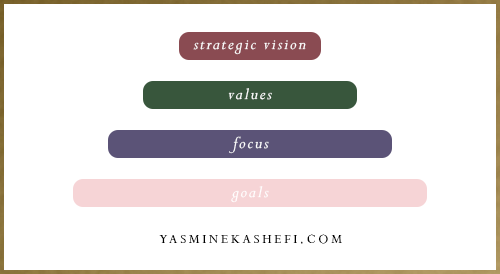
Having a plan is crucial to success in your business. Sure, you can wing it, but why would you want to? Winging it leads to:
- Scattered focus. You’re not spending your time on the activities that grow your business.
- Disorganization. You have no processes in place and you’re making it up as you go along.
- Money wasted. When you don’t have a plan for growth, your money often gets spent inefficiently or on the wrong things all together.
Does any of that sound familiar? If you’ve experienced one or more of those things as a creative entrepreneur, raise your hand. I definitely did when I dived into launching my first business 3 years ago!
The thing is, a strategic plan doesn’t have to be a 40 page document. Detail is good and your plan should be built out, but if you’re finding yourself off course, completely overwhelmed or just not content with where your business is, you need revisit (or redefine) your strategic vision.
You strategic vision is more than your “why”, it’s the single most important driver of your business. It is your filter for activities you take on, ensuring you maintain focus, have processes and manage your business financials wisely. It’s what everything in your business ladders up to. What do I mean by that? Well, your goals, business focus and values will all be derived from that strategic vision.

You’ve already heard mine. I help creative entrepreneurs achieve balance in their life by building a stable, balanced business that is poised for growth.
Every time I take on a new marketing activity, build a new offering or invest in another specialist or course, I ask myself if the activity will set me up to help others. You’d be surprised at how many times the answer is no.
Your strategic vision should do three things:
- Speak to or identify your audience. Whether your audience is super niche or broad, they need to be addressed in your vision. This helps you remember WHO is at the core of your business. If they’re not mentioned outright, your statement should talk to them.
- Have a positive outcome. What are you trying to achieve with your business? How will you change your client’s life?
- Be concise. Your vision should be one to two sentences tops and very clear. Avoid using vague terms that are hard to define.
One example of a strategic vision that really stuck with me is by my wonderful friend, Maghon Taylor of All She Wrote Notes. When I met Maghon at Inspired Retreat last year and asked about her business, she said
“I spread happiness through my handwriting.”
I remember thinking how spot on that was for her business as a calligrapher. She clearly defines the positive outcome, her statement is super concise and the phrasing speaks to her audience. Most importantly, it’s memorable (I remembered it more than a year later!) and every aspect of her business thoroughly demonstrates the joy she wants her customers to experience through her work. If you haven’t visited her site yet, you are in for a treat! Her work is gorgeous!
What other examples of great strategic visions can you think of? I have a few more examples in mind, but I’ll use them as I go through the next part of this series on Strategy. Stay tuned to learn how you can leverage values to maintain balance in your biz.
Want feedback on your strategic vision? Go ahead and send me a note, I’d be happy to review it!

Leave a Reply